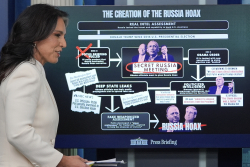
In 2014, Congress authorized grants for Assisted Outpatient Treatment (AOT), a court-ordered program for untreated serious mental illness, and required the Department of Health and Human Services to study the impact. Earlier this month, the Government Accountability Office published a report on the three HHS evaluations produced since the program’s inception 11 years ago. The GAO determined that the HHS evaluations were “inconclusive.”
While the report gives the impression that the HHS evaluations produced new evidence, in reality, it marks the end of a bureaucratic box-checking exercise. The federal government has never seriously studied AOT. Now, its latest claims risk undermining a highly effective program—making both the mentally ill and the public less safe.
Finally, a reason to check your email.
Sign up for our free newsletter today.
AOT is neither new nor radical; it has existed for decades. It serves a narrow subset of individuals with untreated serious mental illnesses, such as schizophrenia and other psychotic disorders, who have a history of treatment noncompliance leading to repeated arrests or hospitalizations. When such individuals fail to seek or follow voluntary treatment and cannot survive in the community without supervision, judges may use AOT to mandate community-based services, such as mental-health treatment (psychotherapy or medication) and case management, aimed at preventing violence, self-harm, incarceration, and hospitalization.
While the federal government has neglected AOT, independent evaluations have found impressive outcomes. New York State’s AOT program, called Kendra’s Law, has been studied extensively since it was established in 1999. Participation in the program has been found to reduce homelessness dramatically (by 74 percent), arrests (by 83 percent), incarceration (by 87 percent), and hospitalizations (by 77 percent). Perhaps the most impressive aspect of AOT is that these outcomes are demonstrated for patients with some of the most complex disorders and most severe needs.
The federal government didn’t add to this evidence base. In each of the HHS evaluations—which included two reports to Congress by the subagency SAMHSA, responsible for mental illness, and the subagency ASPE, responsible for policy evaluation and implementation—the data used were almost exclusively self-reported survey responses from participants and staff.
One cannot draw reliable or representative conclusions from such limited data. In fact, the HHS evaluations were so inadequate that the GAO declined to report their specific outcomes, stating that they could not support any generalizable findings.
Why is better data lacking? In part, because jurisdictions could receive grants under the 2014 law only if they were creating a new AOT program—meaning, by design, no funds went to established programs with the data needed to evaluate AOT’s benefits rigorously.
AOT grantees reviewed by HHS were not just new and unestablished—they were also often “AOT” in name only. Court-mandated treatment, by definition, is involuntary treatment. Yet five of the six grantee programs reviewed in one evaluation were voluntary. That means that, whatever was evaluated, it wasn’t AOT. If the GAO report offers any useful conclusion, it’s that program fidelity matters.
In presenting their findings as “inconclusive,” the GAO and HHS make it easy to argue that the program as a whole doesn’t work. Ideological opponents have already done so, with one group saying that the report shows AOT is a “failed model.” That’s not accurate.
Critics decry AOT for infringing on civil liberties. They overlook the civil consequences of inaction: public disorder, violence, self-harm, and even greater restrictions on life and liberty through incarceration or institutionalization. There is nothing compassionate about allowing someone in the grip of psychosis to languish on the streets or behind bars in the name of preserving his “right” to do so.
The greatest irony is that such a small program has drawn such intense scrutiny. AOT has received only $146 million in federal dollars since 2014. Where are the calls to review the billions spent annually on bogus population-level mental-health initiatives that do little more than push ideological agendas? Programs like Mental Health First Aid or mental-health awareness training, suicide awareness and prevention training, universal school-based mental–health programs, and widespread mental-health and suicide-risk screenings have not reduced mental-disorder prevalence rates or suicide rates. What’s more, there’s evidence that these efforts can be harmful, leading to overdiagnosis and overmedicalization, greater risk of suicidal intent, worse mental health, and worse life outcomes.
Congress is right to demand accountability for how federal funds are spent. But bad evaluations don’t serve that goal. AOT doesn’t need to reinvent its model from scratch; nor does it need another round of poorly designed studies that obscure what works. The federal government should focus on expanding high-fidelity AOT programs and eliminating the obstacles that hinder their effectiveness.
Photo: Justin Paget / DigitalVision
City Journal is a publication of the Manhattan Institute for Policy Research (MI), a leading free-market think tank. Are you interested in supporting the magazine? As a 501(c)(3) nonprofit, donations in support of MI and City Journal are fully tax-deductible as provided by law (EIN #13-2912529).
Source link

















